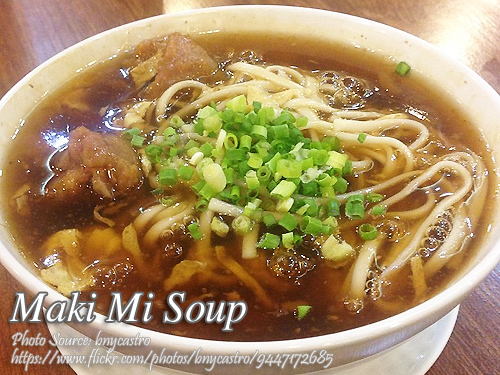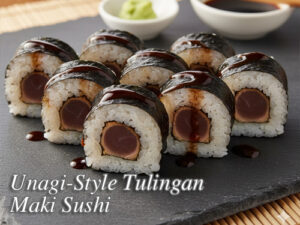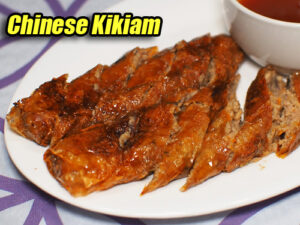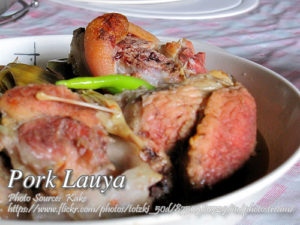Maki mi soup is one of my favorite Chinese food and I remember when I was still in highschool this is always served in a small fastfood (Ha Yuan) near our school. I think this is one of the most tastiest soup served in some panciterias in Binondo. Ha Yuan had a branch in Megamall years ago but it disappeared so I was very disappointed because it was kind of a comfort food to me. But they have other branches in Makati and Quezon city.
Authentic Maki Mi Soup: A Taste of Binondo from My High School Days
Back when I was still in high school, my friends and I had a little after-class ritual. We’d walk down the busy street near campus and slip into this tiny fastfood place called Ha Yuan. It wasn’t fancy—just a few tables, the smell of soy sauce and sesame oil in the air—but to us, it was gold. I always ordered their steaming bowl of maki mi, thick and savory, with tender pork that seemed to melt in your mouth.
Ha Yuan had a branch in Megamall for a while, and I remember dragging my cousin Liza there after a movie, just so she could taste what I’d been talking about. When that branch closed, it felt like a little piece of my comfort food history disappeared. Thankfully, I later found out they still had stores in Makati and Quezon City—like rediscovering an old friend.
The Roots of Maki Mi Soup
Although it’s a familiar sight in many Manila panciterias, maki mi actually has its roots in the Chinese-Filipino community of Binondo. Think of it as a blend of Chinese cooking techniques with local Filipino flavors—pounded pork marinated in seasonings, swimming in a glossy, starchy broth, poured over mami noodles. Its name says it all: maki (the meat and thick soup) and mi (the noodles).
Some say the thickness of the broth was meant to keep the soup hot longer, perfect for cooler weather or for workers taking a quick meal break. Whatever the origin, the combination of tender pork, rich broth, and chewy noodles is comfort food through and through.
Prepping the Pork the Right Way
When I first tried making this at home, I followed my Uncle Boyet’s tip: pound the pork slices before marinating them. It sounds simple, but here’s why it works—the pounding breaks down muscle fibers, making the meat extra tender and helping it absorb the marinade better. A few whacks with the back of a cleaver, and you’re on your way to that melt-in-the-mouth texture.
The marinade is key too—soy sauce, garlic, seasoning liquid, sesame oil, egg, and sweet potato starch. The starch coats the meat so it stays juicy while cooking, and later helps give the broth that signature silkiness.
Building the Perfect Broth
Kuya Jun, who worked in a Binondo noodle shop for years, once told me, “Your broth sets the tone. Don’t rush it.” He was right. Even if you start with ready-made pork or chicken stock, simmer it gently with soy sauce and just enough seasoning to bring out depth without overpowering the pork.
When the pork slices hit the boiling broth, they cook fast. The starch from the marinade seeps into the soup, beginning that transformation from thin to thick.
The Secret Behind That Glossy Finish
The thickening step is where many beginners get nervous. Here’s my tip: mix sweet potato starch with water to make a slurry, then add it slowly to the boiling broth while stirring vigorously. This keeps lumps from forming and ensures the starch cooks evenly, giving that signature glossy, almost velvety texture.
Why it works is all about science—starch granules swell and trap water as they heat, creating a thicker liquid. Too fast, and you’ll get clumps. Too slow, and it won’t thicken properly. Patience is your friend here.
Adding the Final Touches
Once the soup is thick and bubbling, season with salt, pepper, and a touch of sugar. The sugar might seem odd, but my Ate Maribel swears it balances the saltiness and deepens the flavor. Then comes my favorite part: slowly drizzle beaten egg into the hot soup while whisking gently. The egg cooks into delicate ribbons, adding richness and beauty in one go.
For the noodles, fresh mami only needs a quick soak in boiling water, while dried noodles need a few more minutes to cook through. Either way, they should be drained well before ladling the hot soup over them.
Serving Up a Maki Mi Bowl of Comfort
To serve, place the noodles in a bowl, pour over the thick pork soup, and sprinkle with chopped green onions for freshness. The first spoonful always takes me back to those noisy after-school afternoons with friends, the sound of jeepneys outside, and the comfort of knowing my favorite dish was just a few steps away.
Food like this isn’t just about flavor—it’s about memories. Every bowl of maki mi I make now feels like a connection to the past, a little tribute to the cooks and noodle shop owners who kept this tradition alive. If you’re trying it for the first time at home, don’t be afraid to make it your own. After all, that’s how recipes survive—passed from one kitchen to another, with each cook leaving their own mark.
How to Cook Authentic Maki Mi Soup
Ingredients
Ingredients for the pork mixture:
- 1/2 kilo lean pork kasim or pork shoulder will be fine pound till flat then slice into bite sizes
- 2 Tbsp. soy sauce
- 2 cloves garlic finely minced
- 2 drops KNORR Seasoning liquid
- few drops of sesame oil optional
- 1 pc beaten egg plus 2 more beaten eggs to be used later
- 2 Tbsp sweet potato starch
Ingredients for the broth:
- 7 cups broth 6 cups water and 2 Tbsp. chicken powder or 1 piece pork/chicken broth cube
- 3 Tbsp soy sauce
Ingredients for the slurry or thickening agent:
- 6 Tbsp. sweet potato starch
- 6 Tbsp. water
Ingredients for the mami:
- mami noodles egg noodles, dried or fresh
- water
Instructions
How to cook Maki Mi Soup:
- Combine all the ingredients of the pork mixture; pork slices, soy sauce, garlic, seasoning liquid, sesame oil, 1 beaten egg, sweet potato starch. Mix until all the pork slices are coated with the mixture. Set aside.
- Then on a separate bowl, mix together 6 tablespoon sweet potato starch and 6 tablespoon water to make a slurry. You can can add more tablespoon of sweet potato starch to make the soup thicker.
- In a medium size pot, boil the broth mixture (broth and soy sauce) then add the pork slices one by one in the pot. Let the broth boil till the pork cooks. The cooking time won’t take long because the pounded meat is already tenderized and will cook fast.
- While the soup is boiling after the pork is cooked, add the thickening mixture (the slurry) slowly and mix the soup vigorously. Let it boil till it becomes glossy and bubbly.
- Then add salt and pepper to taste and a little bit of sugar, about 1/4 teaspoon or more.
- Turn off the heat and while the soup is hot add the beaten egg slowly while whisking the soup.
- To prepare the mami, if you bought dried mami noodles, cook according the package directions. Usually you only need to boil it. Fresh mami on the other hand only need to be soaked in boiling water for a few minutes then drain.
- To prepare the maki mi soup, get a medium serving bowl and put some cooked mami. Then pour it with the thick maki soup. Garnish it by sprinkling chopped scallion or green onions. Serve hot and enjoy!
Video
Notes
Cooking Tips:
Tenderizing the Pork for Maximum Flavor
Pound the pork slices lightly before marinating to break down tough muscle fibers. This step allows the marinade to penetrate deeper, infusing each piece with flavor. The result is pork that stays tender and juicy even after simmering in the broth.Achieving the Perfect Soup Thickness
Mix your sweet potato starch with water to create a smooth slurry before adding it to the boiling broth. Add it slowly while stirring constantly to avoid lumps and ensure even thickening. This will give your maki mi its signature glossy and silky texture.Balancing the Seasoning
Add a pinch of sugar along with your salt and pepper to balance the savory flavors of the soup. This small touch enhances the broth’s depth without making it taste sweet. Taste as you go so you can adjust the seasoning to your preference.






Hi,
I really miss this Maki Mi. since we are already living in the province I can’t go to Ha Yuan’s. But, this would bring back the memories….Thanks Alot!
Hi Maui, thanks also for sharing your comment!
Hi. I made this for dinner tonight. It was a total hit. I wasn’t able to get the ‘blackish’ color since it came out kinda lighter in shade, but my, they adored my cooking. I used tapioca starch instead of the sweet potato one since I cannot find them in the supermarket. I doubled the amount tho since I like my soup really gooey. Thank you for the recipe. Will try the gourmet tuyo next.
Hi Anne Marie, thanks for sharing your experience in cooking this dish. And about the color of the maki mi, I think adding more soy sauce will give you a darker shade.
I love maki mi, miss Ha yuan place. I will try to cook this tomorrow. Thank you for sharing
Hi Stella, thanks also for visiting and your comment!
Thank you very much Manny. Six of my siblings went to St Stephen HS. Needless to say Ha Yuan is the Maki mi place and of course fresh lumpia. My brother and I experimented in making maki and not get the Ha Yuan taste. I will try it. My brother’s Oz kids love maki mi too when they visited Manila and tried HaYuan maki mi
Hi Christine, yes you are right Ha Yuan is the maki mi place and I think they are the pioneer in serving maki mi.
Thank you for making this recipe. I been searching this for a long period of time, I went to school at Chang Kai shek college, i missed the foods and friends
Hi Lydia, thanks also for sharing your comment. I hope you will like the dish when you cook it using this recipe.
Me and my classmates would take a jeep from Recto to Magdalena just to eat Ha Yuan’s Maki Mi and Camto Mi. It’s as if I could still taste it…thanks for the recipe…now I won’t really miss it that much, everytime I cook it. Could you post Ha Yuan’s Camto Mi and fresh lumpia recipes please.
Hi Cecilia, thanks for dropping by. Actually Camto Mi and fresh lumpia is my favorite when eating in Ha Yuan’s, maki mi is only secondary 🙂 I love the curry flavor and aroma of camto mi. I hope I could find the camto mi imitation recipe and fresh lumpia from Ha Yuan’s so I could post it here.
Hi Aida, I’m happy that you like the recipe.
Thank you for your generous for giving out your recipe.
I LOVE MAKI MI
Hi Jerson, yes cornstarch is the ideal substitute and also cassava starch, but the sweet potato starch is really different in consistency and has a unique sticky and gooey properties.
Hello, can you please make a video on how to cook Maki Mi. Also where can I buy these ingredients such as sweet potato starch. Maki Mi is also my favorite dish, there is no asian restaurants here in the USA that makes them. Thank you.
Hi Maki Mi Lover,
I’ll make a video soon. I think potato starch is available in big supermarkets there in the U.S. If you can’t really find it in your area, you can order online. You can try amazon.com.
You can buy the ingredients in supermarkets. Instead of sweet potato starch you may also use corn starch as substitute same measurement will do.